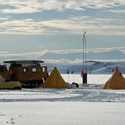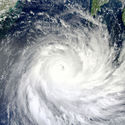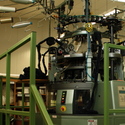Paul Andrew Mayewski’s professional profile lists him as a glaciologist, climate scientist and explorer. Paul has led more than 55 expeditions to some of the most remote places on Earth – busting the myth of the white-coated scientist working alone in a corner of the lab. Occasionally, when bunking with several others in a small box for weeks on end, Paul might like this stereotype to be true!
Paul and his colleague Daniel Dixon spend periods of up to 3 months traversing Antarctica using a tractor train – a combination of vehicles, Siglin Sleds and small, insulated living quarters. They cover 1,000 kilometres in a season to collect ice cores. Their progress is slow as they have to continuously watch for crevasses (cracks and holes) in the ice. Temperatures are also well below freezing – down to -50°C at times. Isolation means the team needs to carry everything they require for their 3-month journey in a hostile environment.
When you’re out in the field with a group like this, you have no one to rely on apart from yourself and the others. So it’s quite a challenge, and that’s really what keeps me coming back.
Daniel Dixon
Adventure and the nature of science
Adventure, challenge, discovery, problem solving – these seem fitting words to describe the type of research Paul and Daniel do. But they are also what motivate many scientists. The quest to discover something new or to answer a question makes science exciting – and it is just as true for scientists working behind a computer as it is for those who travel on the ice.
Scientists are also motivated by the opportunity to respond to societal needs or solve practical problems. For example, Paul and Daniel drill ice cores to get information about changes to CO2 levels over time. There is a correlation between warmer atmospheric temperatures (climate change) and rising CO2 levels.
An understanding of past climatic conditions can help make predictions about future climates. Paul and Daniel’s research therefore contributes to scientific understanding about climate change – one of society’s biggest challenges – and as Daniel points out, they also get to solve practical problems on a regular basis.
For all scientists, the thrill of discovery is just one part of the job. It takes hard work to verify the discovery or to integrate it into existing knowledge. Paul and Daniel’s time on the ice is followed by lots of work and thinking back at the University of Maine Climate Change Institute in the United States, analysing the ice cores, interpreting the data and matching these interpretations with other scientific evidence.
Adventure, innovation and the nature of technology
Technology is purposeful intervention by design. Paul, Daniel and their epic traverses showcase the role and importance of technology to Antarctic research. The types of equipment they use are great examples of adaptation, innovation and fit for purpose – characteristics of the nature of technology.
Today’s Antarctic adventurers have many advantages over the early expeditions. Transportation has certainly improved. Sir Edmund Hillary’s converted Massey Ferguson tractors were a step up from the horses and dogs used in the early 20th century expeditions, and today’s Challenger 55 and PistenBully vehicles are a step up again.
Accommodation is another example of the advances in technology. Paul, Daniel and the team sleep in mobile ‘blue boxes’ mounted on skis. They don’t have to worry about using their ice axes as tent pegs during blizzards – like Robert Falcon Scott and other early explorers had to. Generators and heaters also make living conditions reasonably comfortable within the confines of the tractor trains.
Halley VI Research Station
In 1956, the British Antarctic Survey (BAS) established Halley Station on the Brunt Ice Shelf. The ice shelf is slowly moving towards the open ocean, and the area receives 1.2 m of snow annually, so the location poses some challenges to those living there for months at a time.
The original building was a timber hut, and the weight of accumulated snow eventually crushed it. Subsequent buildings (Halley Stations II–IV) used innovative designs – starting with steel reinforcement and moving on to constructing the buildings inside 9 m plywood tubes – but each had to be abandoned due to the heavy snow. Halley V (1989) was built on platforms that were raised each year to keep the buildings above the snow surface. Halley VI (2012) is the latest iteration. It has hydraulic legs and giant retractable skis so the buildings can be relocated as cracks appear in the ice shelf, as happened in January 2017.
Nature of science
One of the best parts of a scientific career is the opportunity to travel the world. Whether it’s visiting field sites, attending conferences or learning new skills, the international nature of scientific research and collaboration make it possible to work all over the globe!
Adventure and innovation – is it worth it?
Why does BAS continue to rebuild the Halley Station? Halley scientists have been collecting meteorological and atmospheric information from the area since 1956. It was their long-term data that helped British scientists discover the hole in the ozone layer. A global effort to ban CFCs 30 years ago is paying off. The ozone hole is no longer as large nor as deep as it once was.
It is discoveries made by scientists like those at BAS and like Paul and Daniel – and the global efforts that come from this knowledge – that will hopefully slow and reverse global climate change.
Related content
Monitoring Antarctic sea ice and the role that models play in prediction of ice melt and its consequences is crucial, explore more in this Conversation article.
Useful links
Find out more about the work of Dr Paul Mayewski on his profile on the The University of Maine's Climate Change Institute website and Dr Daniel Dixon's profile on the On Thin Ice website.
In 2016/17, the British Antarctic Survey relocated the Halley VI Research Station to a safer location on the Brunt Ice Shelf. This BAS video shows how the pods were moved.
Learn more about the BAS’s tractor train traverse systems.
To get a feel for what it is like to travel in less than idea conditions, watch the BAS YouTube video showing PistenBully-led tractor train.
Live Science explores some of the new technologies driving Antarctic science.
New Zealand History has extensive resources on Edmund Hillary in Antarctica, including audio of Sir Ed discussing dogs versus tractors.
Caterpillar’s Challenger tractors are used to pull traverse trains across Antarctica. This YouTube video shows how the farm tractors are transformed into Antarctica-ready, scientific research and support vehicles.
Acknowledgement
Thin Ice – The Inside Story of Climate Science, a David Sington/Simon Lamb film, looks at what’s really happening with global warming by filming scientists at work in the Arctic, the Antarctic and around the world. It gives a 56-minute view of the range of human activity and scientific work being undertaken to understand the world’s changing climate. The result is a unique exploration of the science behind global warming and an intimate portrait of a global community of researchers racing to understand our planet’s changing climate.
The Science Learning Hub has produced a series of articles using short video resources produced by the Thin Ice team. The film itself is available by emailing thiniceclimate@vuw.ac.nz. It is recommended viewing to give students context for the Hub’s articles and the videos they contain. The link for streaming is available free of charge. The DVD is also available to New Zealand schools for $20 to cover costs.
Learn more at www.thiniceclimate.org.









